A Dual-Band Modified Franklin mm-Wave Antenna for 5G Wireless Applications
Abstract
:1. Introduction
2. Antenna Design Approach
2.1. Proposed Antenna Configuartion and Dimension Layout
2.2. Design Steps to Obtain the Proposed Antenna
3. Parametric Analysis
3.1. Effect of Length of Patch Element PL
3.2. Effect of Incremental Length R
3.3. Effect of the Width of the First Type of Ground Cut WG
3.4. Effect of the Width of the Second Type of Ground Cut WC
3.5. Effect of Length of First Type Ground Cut LG
3.6. Effect of Length of Second Type Ground Cut LC
4. Results and Discussion
5. Conclusions
Author Contributions
Funding
Institutional Review Board Statement
Informed Consent Statement
Data Availability Statement
Conflicts of Interest
References
- Goldsmith, A. Wireless Communications; Cambridge University Press: New York, NY, USA, 2005. [Google Scholar]
- Balanis, C.A. Antenna Theory: Analysis and Design; John Wiley & Sons: New York, NY, USA, 2016. [Google Scholar]
- Huang, K.-C.; Zhao, C. Millimetre Wave Communication Systems; Wiley: Hoboken, NJ, USA, 2011. [Google Scholar]
- Ali, T.; Aw, M.S.; Biradar, R.C. A Compact Bandwidth Enhanced Antenna Loaded with SRR For WLAN/WiMAX/Satellite Applications. Adv. Electromagn. 2018, 7, 78–84. [Google Scholar] [CrossRef]
- Ali, T.; Subhash, B.K.; Pathan, S.; Biradar, R.C. A compact decagonal-shaped UWB monopole planar antenna with truncated ground plane. Microw. Opt. Technol. Lett. 2018, 60, 2937–2944. [Google Scholar] [CrossRef]
- Ndip, I.; Le, T.H.; Schwanitz, O.; Lang, K.-D. A comparative analysis of 5G mmWave antenna arrays on different substrate technolgies. In Proceedings of the 2018 22nd International Microwave and Radar Conference (MIKON), Poznan, Poland, 14–17 May 2018; pp. 222–225. [Google Scholar]
- Jilani, S.F.; Alomainy, A. A multi-band millimeter-wave 2-D array based on enhanced Franklin antenna for 5G wireless systems. IEEE Antennas Wirel. Propag. Lett. 2017, 16, 2983–2986. [Google Scholar] [CrossRef]
- Pi, Z.; Khan, F. An introduction to millimeter-wave mobile broadband systems. IEEE Commun. Mag. 2011, 49, 101–107. [Google Scholar] [CrossRef]
- Solbach, K. Microstrip-Franklin Antenna. IRE Trans. Antennas Propag. 1982, 30, 773–775. [Google Scholar] [CrossRef]
- Alrifai, A.A. Improving the Frequency Range of Franklin’s Antenna. Int. J. Commun. Antenna Propag. (IRECAP) 2017, 7, 410. [Google Scholar] [CrossRef]
- Maharjan, J.; Kim, S.-W.; Choi, D.-Y. Franklin Array MIMO Antenna for 5G Applications. In Proceedings of the 2019 34th International Technical Conference on Circuits/Systems, Computers and Communications (ITC-CSCC), JeJu, Korea, 23–26 June 2019; pp. 1–4. [Google Scholar]
- Polivka, M.; Holub, A.; Mazanek, M. Collinear microstrip patch antenna. Radioengineering-prague 2005, 14, 40. [Google Scholar]
- Holub, A.; Polivka, M. Collinear microstrip patch antenna. In Passive Microwave Component and Antennas; InTech: Rijeka, Croatia, 2010; pp. 513–530. [Google Scholar]
- Kuo, C.H.; Lin, C.C.; Sun, J.S. Modified microstrip Franklin array antenna for automotive short-range radar application in blind spot information system. IEEE Antennas Wirel. Propag. Lett. 2017, 16, 1731–1734. [Google Scholar] [CrossRef]
- Chang, S.-H.; Liao, W.-J.; Peng, K.-W.; Hsieh, C.-Y. A Franklin Array Antenna for Wireless Charging Applications. PIERS Online 2010, 6, 340–344. [Google Scholar] [CrossRef] [Green Version]
- Wang, P.P.; Antoniades, M.A.; Eleftheriades, G.V. An Investigation of Printed Franklin Antennas at X-Band Using Artificial (Metamaterial) Phase-Shifting Lines. IEEE Trans. Antennas Propag. 2008, 56, 3118–3128. [Google Scholar] [CrossRef]
- Chaudhuri, S.; Kshetrimayum, R.S.; Sonkar, R.K. High Inter-port Isolation Dual Circularly Polarized Modified Franklin Microstrip Antenna. In Proceedings of the 2019 13th European Conference on Antennas and Propagation (EuCAP), Krakow, Poland, 31 March–5 April 2019; pp. 1–4. [Google Scholar]
- Jilani, S.F.; Alomainy, A. Millimeter-wave conformal antenna array for 5G wireless applications. In Proceedings of the 2017 IEEE International Symposium on Antennas and Propagation & USNC/URSI National Radio Science Meeting, San Diego, CA, USA, 9–14 July 2017; pp. 1439–1440. [Google Scholar]
- Boas, E.C.; Alves, A.A.C.; Ribeiro, J.A.J.; Cerqueira, S., Jr. A Novel Dielectric Slab Antenna Based on Microstrip-Franklin Excitation for mm-Waves. Journal of Microwaves. Optoelectron. Electromagn. Appl. 2020, 19, 203–213. [Google Scholar] [CrossRef]
- Vanaja, C.; Pavithra, N.; Sravya, N.; Manoj, M.; Dhanade, Y.B. Enhanced Franklin Antenna for the Future 5G Communication Applications. IJITEE 2019, 8, 1–5. [Google Scholar]


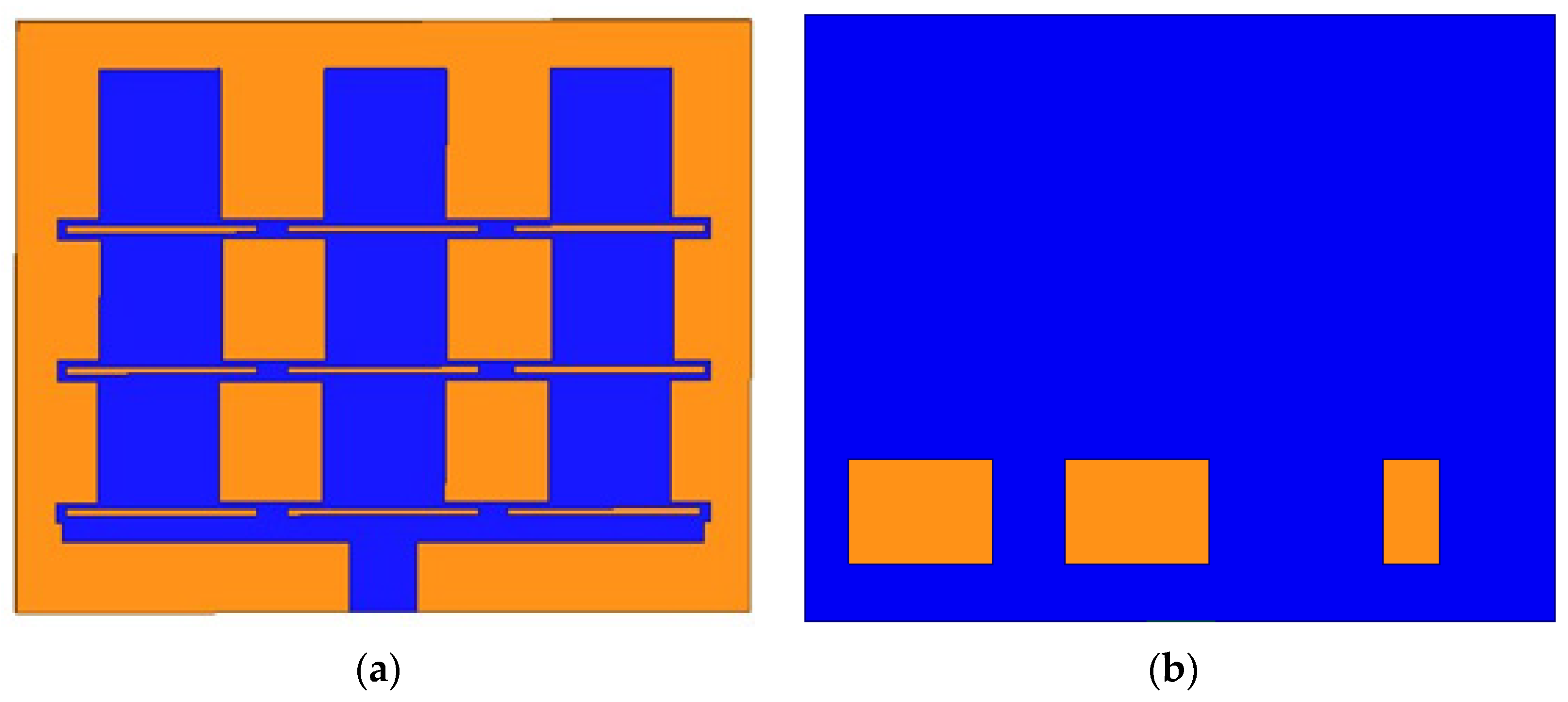

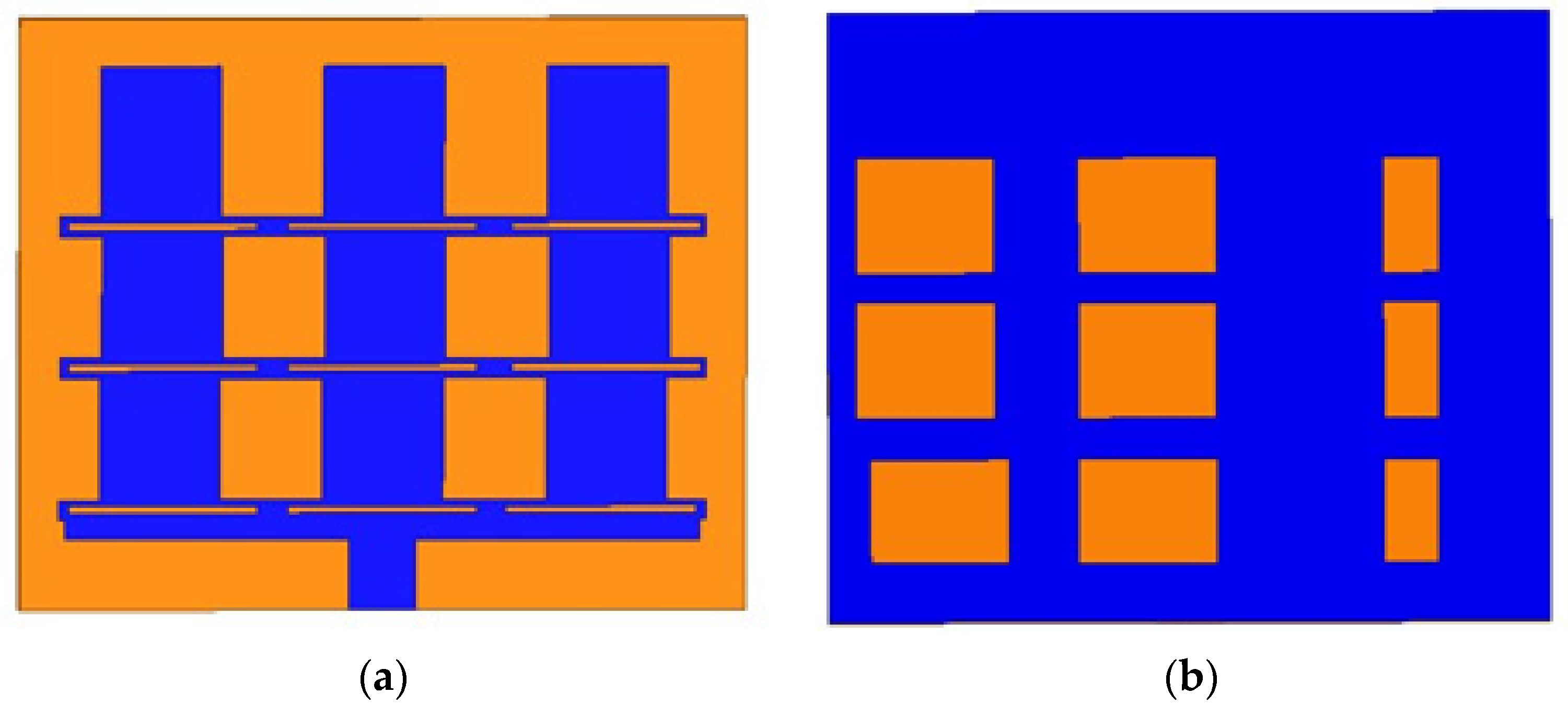

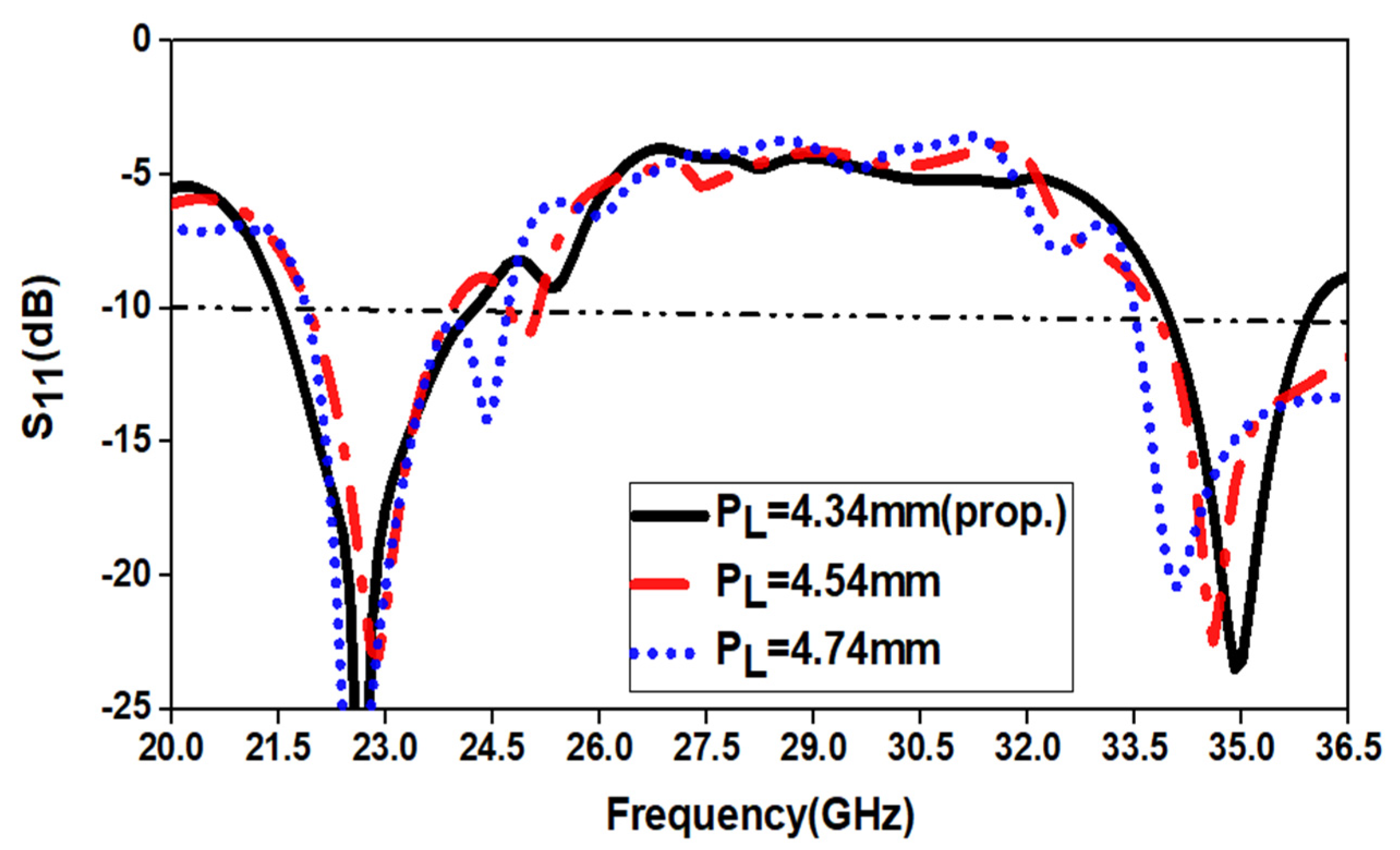
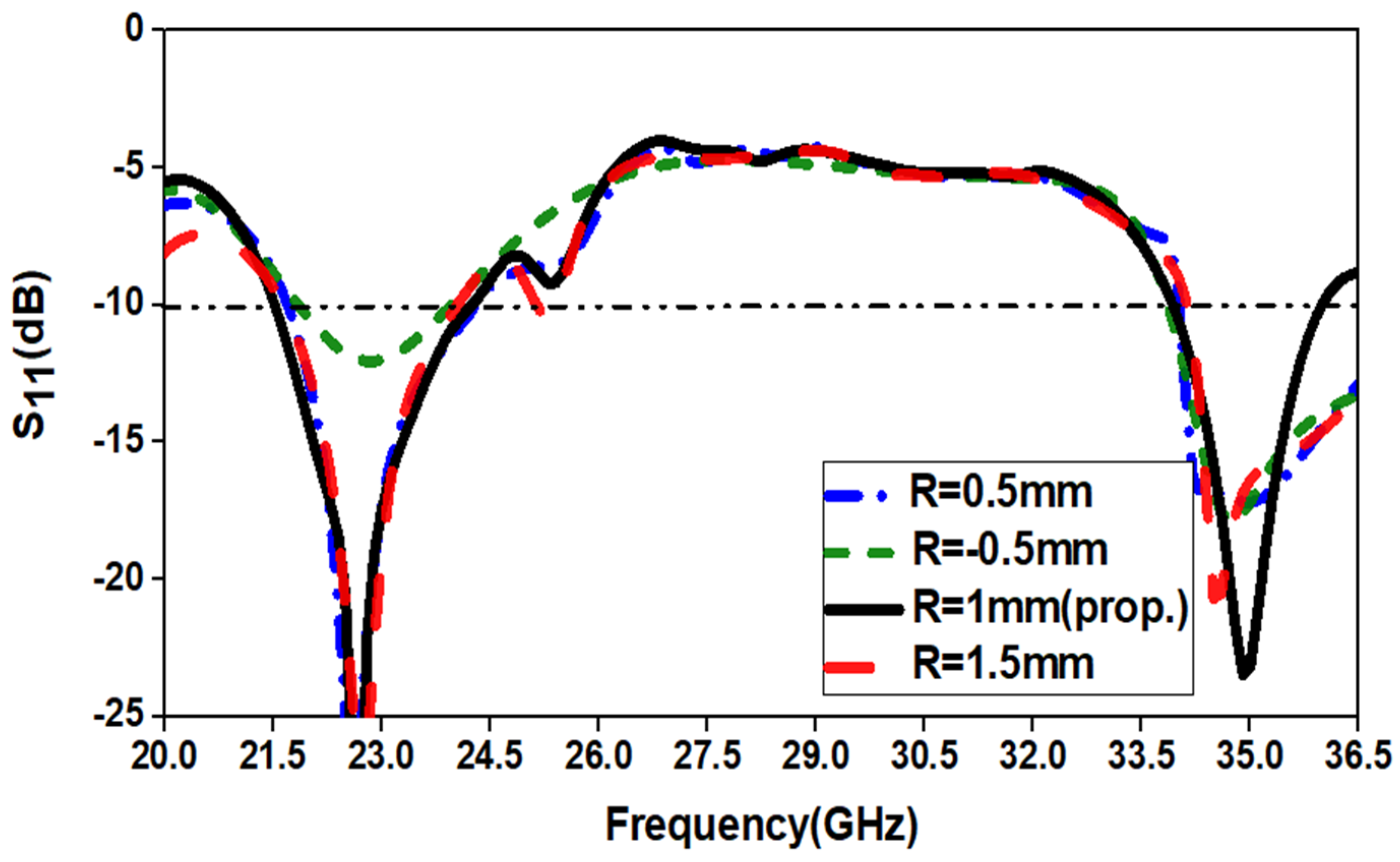
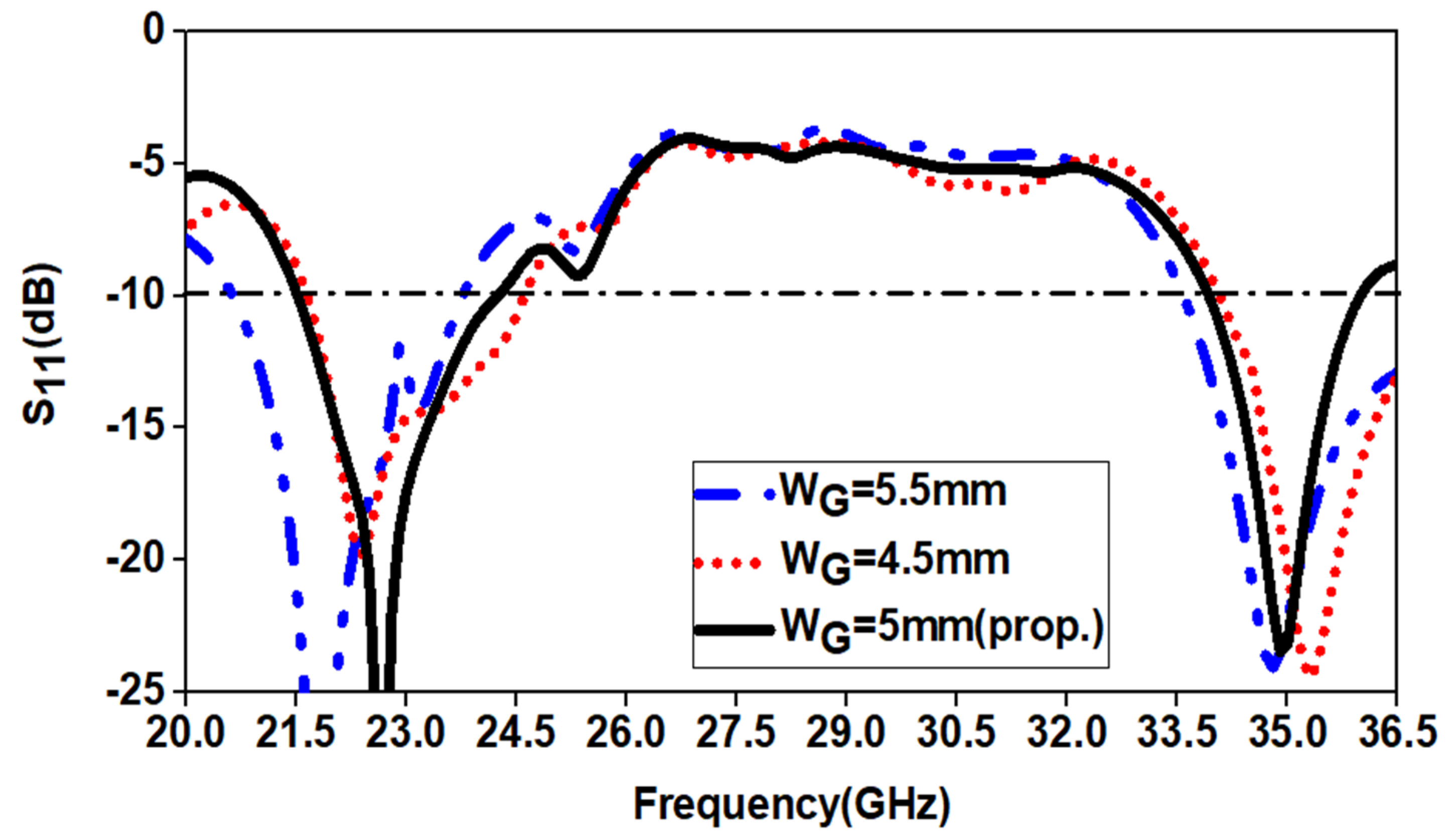
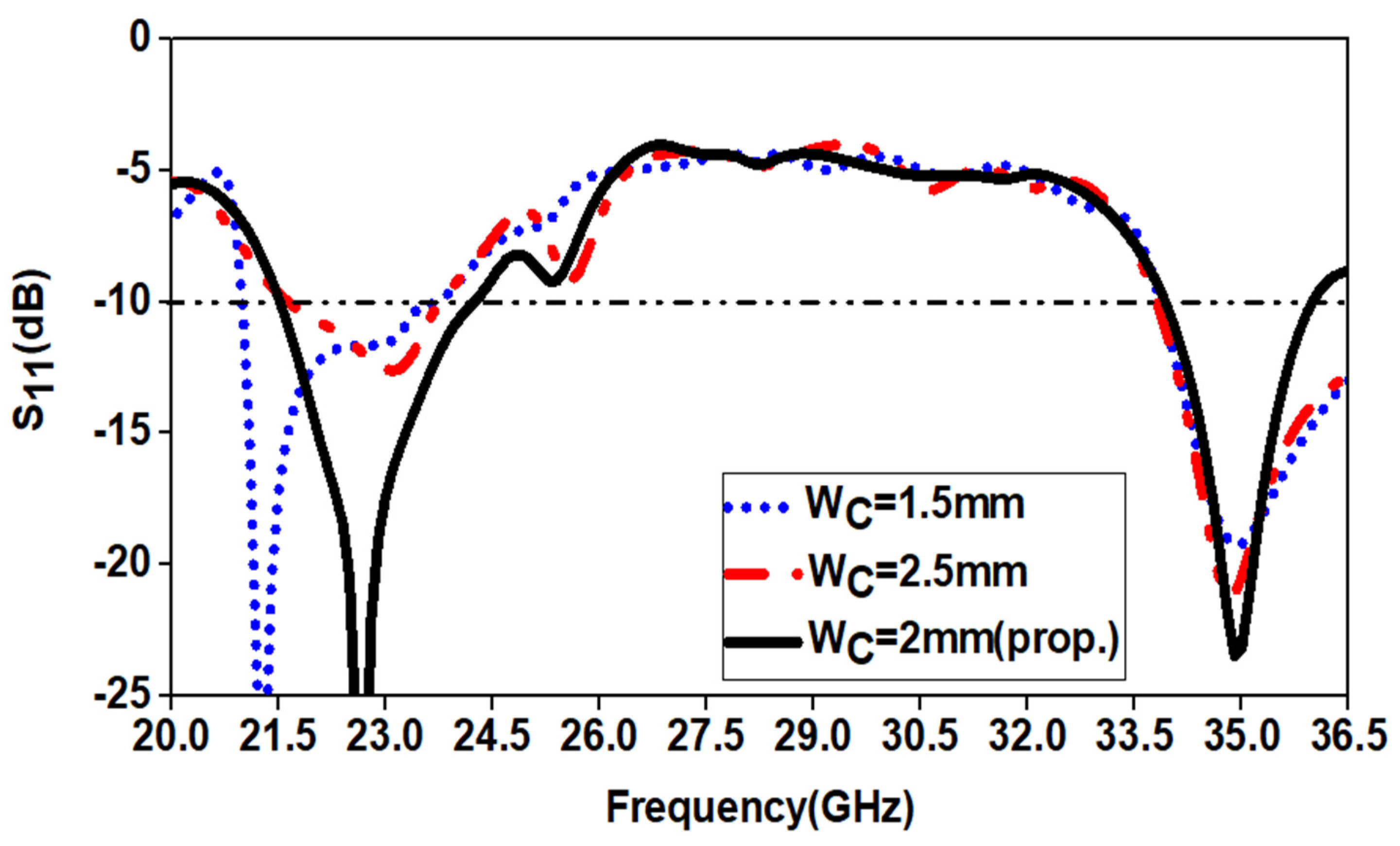
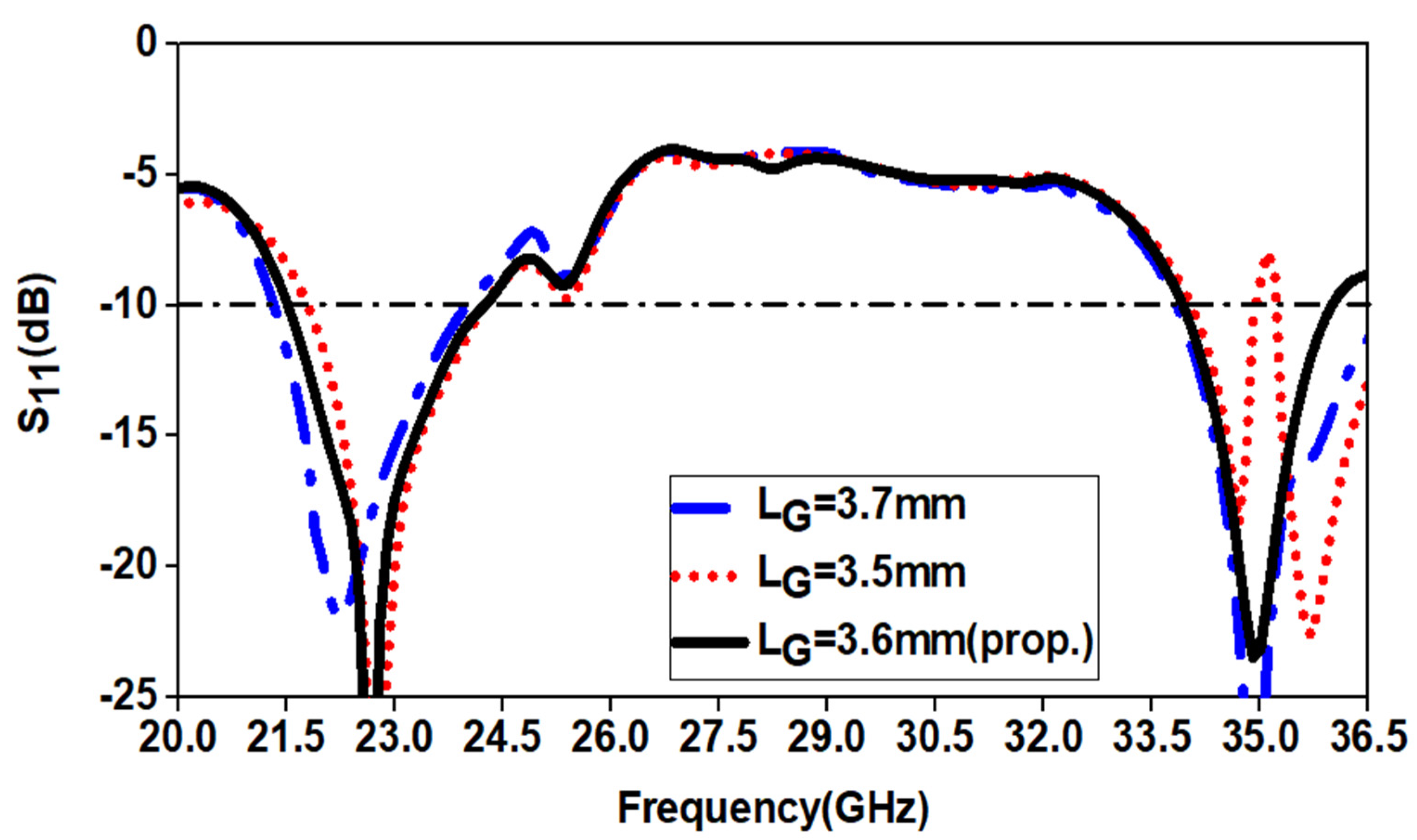

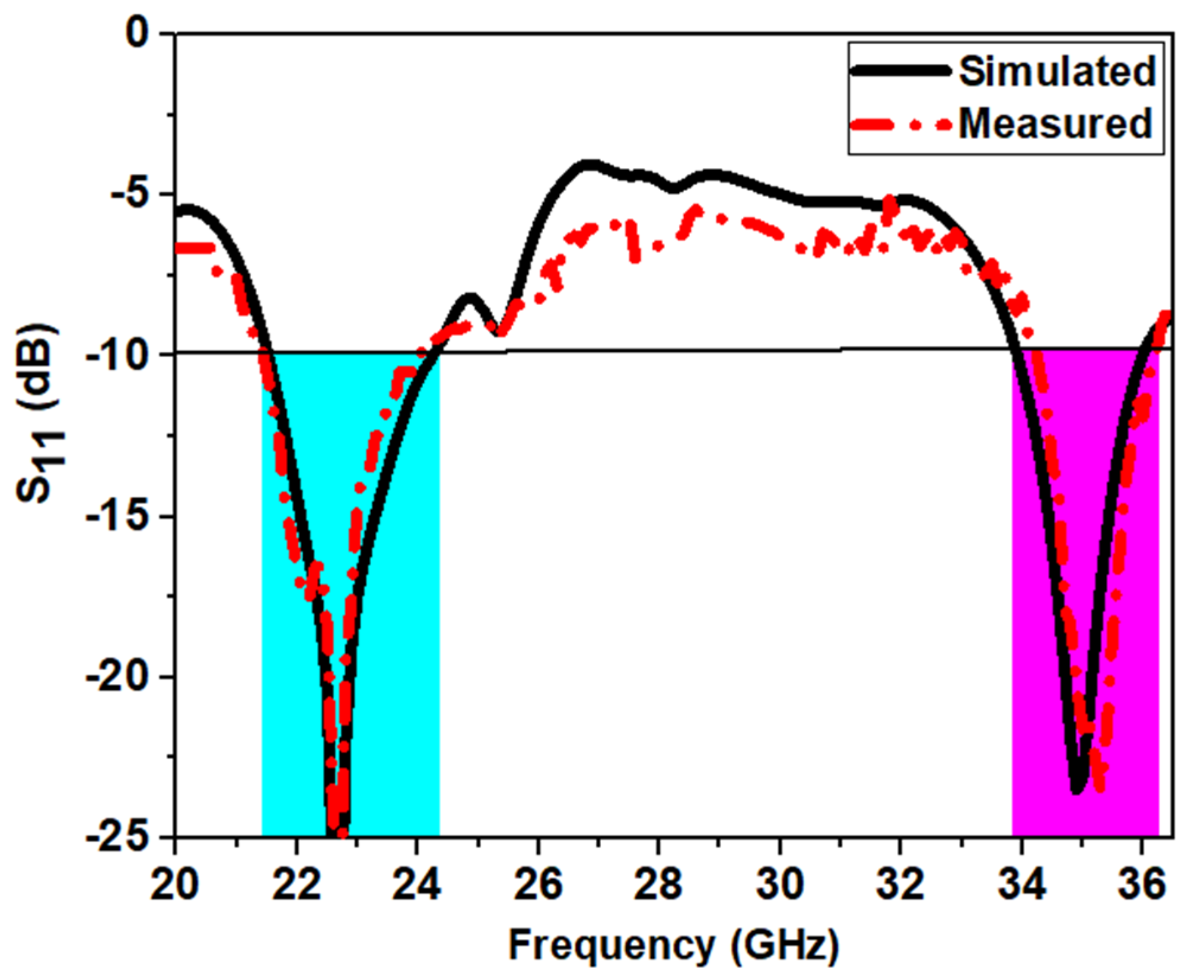
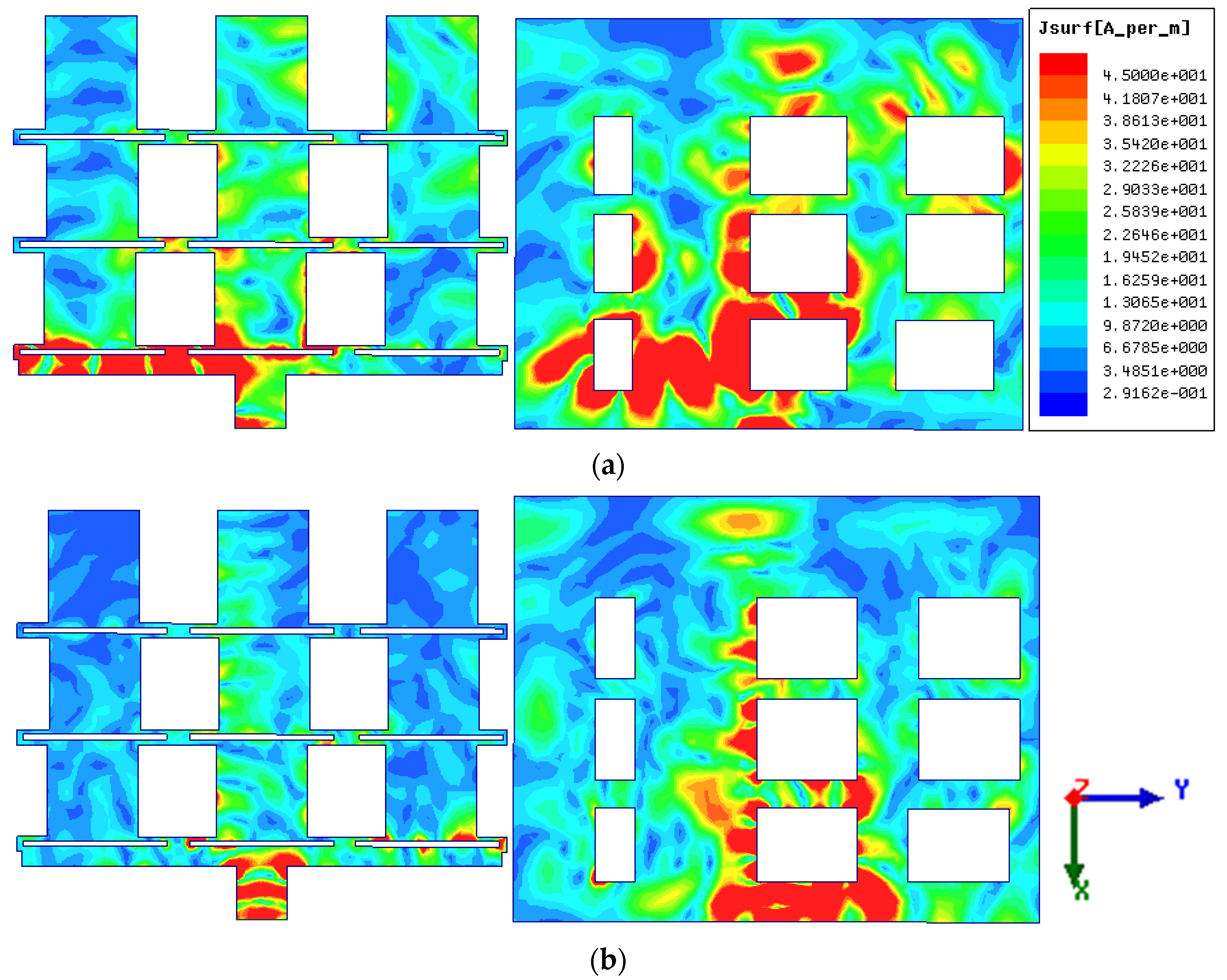



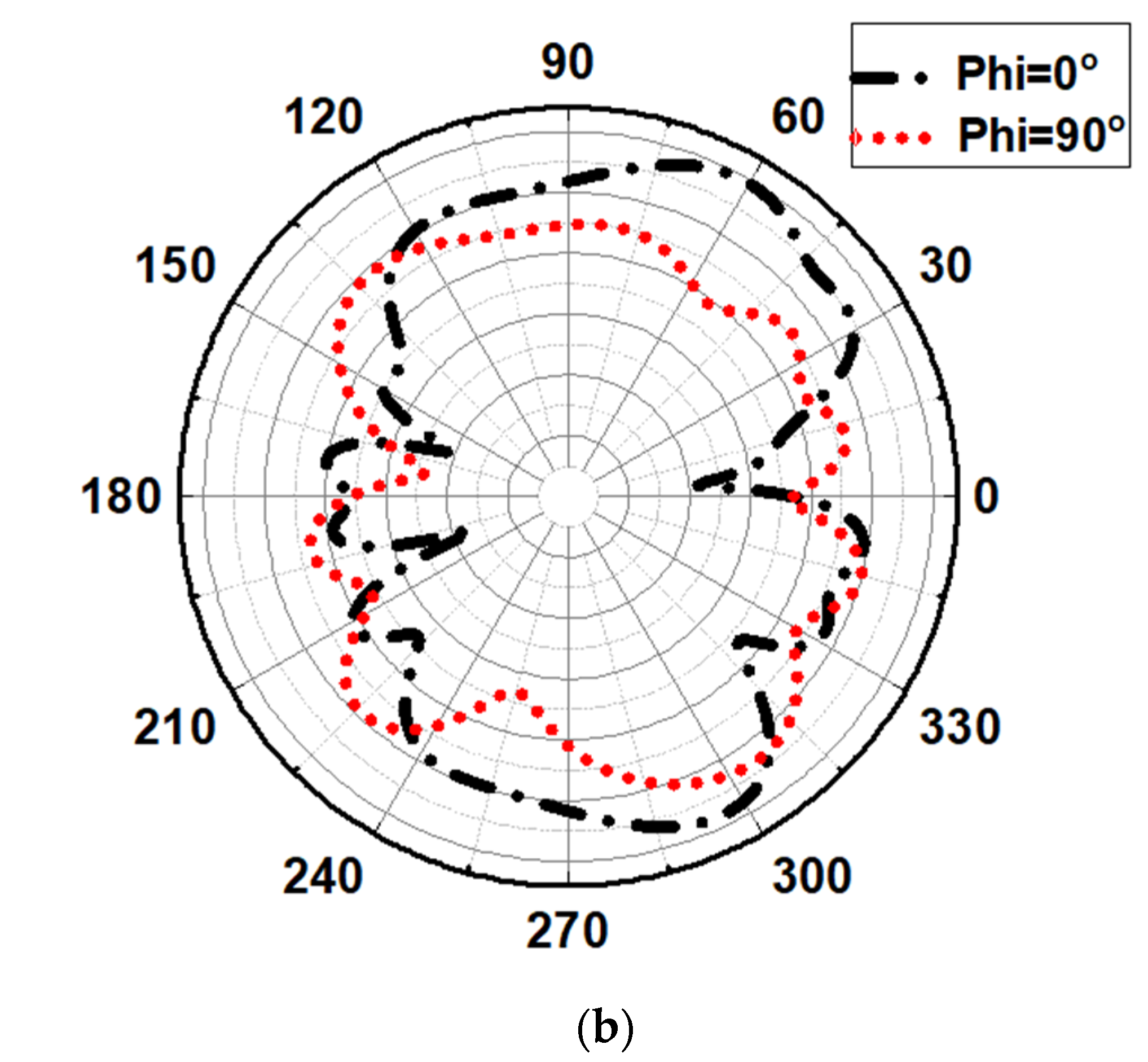
| Symbol | Parameters | (mm) |
|---|---|---|
| PL | Patch element length | 4.34 |
| PW | Patch element width | 4.3 |
| R | Patch element length extension for the first row | 1.0 |
| J | Spacing between the centers of patch elements in a row | 8.01 |
| FL | Folded dipole length | 1.4 |
| FW | Folded dipole width | 0.7 |
| SW | Matching stub width | 10.15 |
| SL | Matching stub length | 1.4 |
| fL | Feed length | 3.2 |
| fW | Feed width | 2.4 |
| Fg | The gap of the folded dipole | 0.26 |
| L | Length of substrate material | 21.0 |
| W | Width of substrate material | 26.0 |
| WG | Width of first type ground cut | 5.0 |
| WC | Width of second type ground cut | 2.0 |
| LG | Length of first type ground cut | 3.6 |
| LC | Length of second type ground cut | 4.0 |
| Ref. | Antenna Type | No of Elements | Resonating Frequency (GHz) | Bandwidth (%) | Gain (dBi) | Size (mm2) | Advantage |
|---|---|---|---|---|---|---|---|
| [12] | Collinear Microstrip Patch Antenna | 3 | 0.869 | 2.80 | 12.4 | It has a directional pattern. | |
| [13] | Collinear Microstrip Patch Antenna | 3 | 2.4 | 7.10 | 15.8 | Simple structure without the need for any feeding network. | |
| [14] | Modified Microstrip Franklin Array Antenna | 1, 3, and 5 | 24 | 1.04 | 6, 8, and 11 | High absolute gain, good directivity, and large-range coverage. | |
| [15] | Franklin Array Antenna | 32 | 2.4 | 8.33 | 12 | High gain, enlarged antenna aperture, increase in available power. | |
| [17] | Circularly Polarized Franklin Microstrip Antenna | 12 | 6.9 | 5.76 | 3.1 | More than 64% of the −10 dB impedance bandwidth is usable in CP mode, low axial ratio, high inter-port isolation, and squinted beams. | |
| [18] | Conformal Antenna array | 6 | 29 | 19.78 | 8.3 | Compact, flexible, and wideband antenna array | |
| [19] | Dielectric Slab Antenna based on microstrip-Franklin Excitation | 1 | 30 | 7.6 | 6.6 | Simple planar geometry. | |
| [20] | Enhanced Franklin antenna with defected ground structure | 9 | 25.2 | 22.22 | 10.1 | Directive radiation pattern and cost effective | |
| Proposed Antenna | 9 | 22.7 and 34.9 | 12.2 and 6 | 7.8 and 9.73 | Compact size, multiband operation, directive radiation pattern, simple and planar structure. |
Publisher’s Note: MDPI stays neutral with regard to jurisdictional claims in published maps and institutional affiliations. |
© 2021 by the authors. Licensee MDPI, Basel, Switzerland. This article is an open access article distributed under the terms and conditions of the Creative Commons Attribution (CC BY) license (http://creativecommons.org/licenses/by/4.0/).
Share and Cite
Surendran, A.; B, A.; Ali, T.; Kumar, O.P.; Kumar, P.; Anguera, J. A Dual-Band Modified Franklin mm-Wave Antenna for 5G Wireless Applications. Appl. Sci. 2021, 11, 693. https://doi.org/10.3390/app11020693
Surendran A, B A, Ali T, Kumar OP, Kumar P, Anguera J. A Dual-Band Modified Franklin mm-Wave Antenna for 5G Wireless Applications. Applied Sciences. 2021; 11(2):693. https://doi.org/10.3390/app11020693
Chicago/Turabian StyleSurendran, Arjun, Aravind B, Tanweer Ali, Om Prakash Kumar, Pradeep Kumar, and Jaume Anguera. 2021. "A Dual-Band Modified Franklin mm-Wave Antenna for 5G Wireless Applications" Applied Sciences 11, no. 2: 693. https://doi.org/10.3390/app11020693









